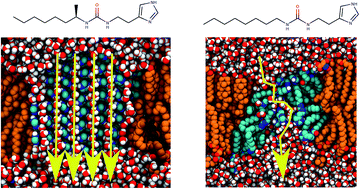当前位置:
X-MOL 学术
›
Faraday Discuss.
›
论文详情
Our official English website, www.x-mol.net, welcomes your
feedback! (Note: you will need to create a separate account there.)
Water permeation across artificial I-quartet membrane channels: from structure to disorder
Faraday Discussions ( IF 3.3 ) Pub Date : 2018-05-02 , DOI: 10.1039/c8fd00046h Samuel Murail 1, 2, 3, 4 , Tudor Vasiliu 5, 6, 7, 8 , Andrei Neamtu 5, 6, 7, 8, 9 , Mihail Barboiu 4, 10, 11, 12 , Fabio Sterpone 13, 14, 15, 16, 17 , Marc Baaden 13, 14, 15, 16, 17
Faraday Discussions ( IF 3.3 ) Pub Date : 2018-05-02 , DOI: 10.1039/c8fd00046h Samuel Murail 1, 2, 3, 4 , Tudor Vasiliu 5, 6, 7, 8 , Andrei Neamtu 5, 6, 7, 8, 9 , Mihail Barboiu 4, 10, 11, 12 , Fabio Sterpone 13, 14, 15, 16, 17 , Marc Baaden 13, 14, 15, 16, 17
Affiliation

|
Artificial water channels (AWCs) have been designed for water transport across membranes with the aim to mimic the high water permeability observed for biological systems such as aquaporins (∼108–109 water molecules per s per channel), as well as their selectivity to reject ion permeation at the same time. Recent works on designed self-assembling alkylureido-ethylimidazole compounds forming imidazole-quartet channels (I-quartets), have shown both high water permeability and total ionic-rejection. I-quartets are thus promising candidates for further development of AWCs. However, the molecular mechanism of water permeation as well as I-quartet organization and stability in a membrane environment need to be fully understood to guide their optimal design. Here, we use a wide range of all-atom molecular dynamics (MD) simulations and their analysis to understand the structure/activity relationships of the I-quartet channels. Four different types with varying alkyl chain length or chirality have been studied in a complex fully hydrated lipid bilayer environment at both microsecond and nanosecond scale. Microsecond simulations show two distinct behaviors; (i) two out of four systems maintain chiral dipolar oriented water wires, but also undergo a strong reorganization of the crystal shape, (ii) the two other I-quartet channels completely lose the initial organization, nonetheless keeping a water transport activity. Short MD simulations with higher time resolution were conducted to characterize the dynamic properties of water molecules in these model channels and provided a detailed hypothesis on the molecular mechanism of water permeation. The ordered confined water was characterized with quantitative measures of hydrogen-bond life-time and single particle dynamics, showing variability among I-quartet channels. We will further discuss the underlying assumptions, currently based on self-aggregation simulations and crystal patches embedded in lipid bilayer simulations and attempt to describe possible alternative approaches to computationally capture the water permeation mechanism and the self-assembly process of these AWCs.
中文翻译:

人工I-四方膜通道中的水渗透:从结构到无序
人造水通道(AWC)设计用于跨膜的水传输,目的是模仿在水通道蛋白等生物系统中观察到的高水渗透性(〜10 8 –10 9个水分子/通道),以及它们同时拒绝离子渗透的选择性。关于设计的自组装烷基脲基-乙基咪唑化合物的最新工作,这些化合物形成了咪唑-四元组通道(I-四元组),显示出高的水渗透性和总的离子排斥性。因此,I四重奏是有希望进一步发展AWC的候选人。然而,透水的分子机制以及四方组织和膜环境中的稳定性需要得到充分的理解,以指导其最佳设计。在这里,我们使用各种全原子分子动力学(MD)模拟及其分析来了解I四方通道的结构/活性关系。已经在复杂的完全水合脂质双层环境中以微秒和纳秒规模研究了四种具有不同烷基链长度或手性的不同类型。微秒模拟显示了两种不同的行为。(i)四个系统中有两个保持手性偶极取向的水线,但也经历了强烈的晶体形状重组;(ii)其他两个I四方通道完全失去了初始结构,但仍保持了水传输活性。进行了具有较高时间分辨率的简短MD模拟,以表征这些模型通道中水分子的动力学特性,并为水渗透的分子机理提供了详细的假设。通过定量测量氢键寿命和单颗粒动力学来表征有序承压水,显示I四重唱频道之间的差异。我们将进一步讨论当前基于自聚集模拟和脂质双层模拟中嵌入的晶体补丁的基本假设,并尝试描述可能的替代方法,以计算方式捕获这些AWC的水渗透机理和自组装过程。
更新日期:2018-09-28
中文翻译:

人工I-四方膜通道中的水渗透:从结构到无序
人造水通道(AWC)设计用于跨膜的水传输,目的是模仿在水通道蛋白等生物系统中观察到的高水渗透性(〜10 8 –10 9个水分子/通道),以及它们同时拒绝离子渗透的选择性。关于设计的自组装烷基脲基-乙基咪唑化合物的最新工作,这些化合物形成了咪唑-四元组通道(I-四元组),显示出高的水渗透性和总的离子排斥性。因此,I四重奏是有希望进一步发展AWC的候选人。然而,透水的分子机制以及四方组织和膜环境中的稳定性需要得到充分的理解,以指导其最佳设计。在这里,我们使用各种全原子分子动力学(MD)模拟及其分析来了解I四方通道的结构/活性关系。已经在复杂的完全水合脂质双层环境中以微秒和纳秒规模研究了四种具有不同烷基链长度或手性的不同类型。微秒模拟显示了两种不同的行为。(i)四个系统中有两个保持手性偶极取向的水线,但也经历了强烈的晶体形状重组;(ii)其他两个I四方通道完全失去了初始结构,但仍保持了水传输活性。进行了具有较高时间分辨率的简短MD模拟,以表征这些模型通道中水分子的动力学特性,并为水渗透的分子机理提供了详细的假设。通过定量测量氢键寿命和单颗粒动力学来表征有序承压水,显示I四重唱频道之间的差异。我们将进一步讨论当前基于自聚集模拟和脂质双层模拟中嵌入的晶体补丁的基本假设,并尝试描述可能的替代方法,以计算方式捕获这些AWC的水渗透机理和自组装过程。











































 京公网安备 11010802027423号
京公网安备 11010802027423号